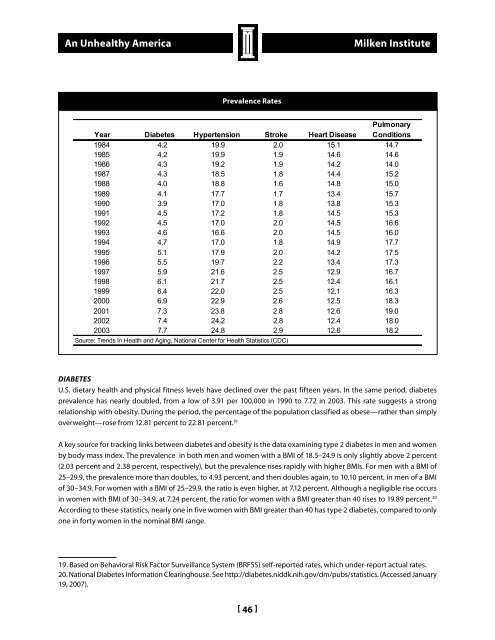An Unhealthy America: The Economic Burden of ... - Milken Institute
An Unhealthy America: The Economic Burden of ... - Milken Institute
An Unhealthy America: The Economic Burden of ... - Milken Institute
You also want an ePaper? Increase the reach of your titles
YUMPU automatically turns print PDFs into web optimized ePapers that Google loves.
<strong>An</strong> <strong>Unhealthy</strong> <strong>America</strong><strong>Milken</strong> <strong>Institute</strong>Prevalence RatesExpenditures PRC* Expenditures/PRCPulmonaryYear DiseaseDiabetes Hypertension (Billions) Stroke (Millions) Heart (Thousands)Disease Conditions1984 Cancer 4.2 19.9 48.1 2.0 10.6 15.1 4.5 14.71985 Breast Cancer 4.2 19.9 5.5 1.91.1 14.6 4.8 14.61986 Colon Cancer 4.3 19.2 3.9 1.90.3 14.211.514.01987 Lung Cancer 4.3 18.5 6.3 1.80.4 14.417.115.21988 Prostate Cancer 4.0 18.8 4.3 1.61.0 14.8 4.1 15.01989 Other Cancers 4.1 17.7 28.0 1.77.7 13.4 3.6 15.71990 Pulmonary Conditions 3.9 17.0 45.2 1.849.2 13.8 0.9 15.31991 Diabetes 4.5 17.2 27.1 1.813.7 14.5 2.0 15.31992 Hypertension 4.5 17.0 32.5 2.036.8 14.5 0.9 16.61993 Heart Disease 4.6 16.6 64.7 2.019.2 14.5 3.4 16.01994Stroke4.7 17.013.61.82.414.95.617.71995Mental Disorders5.1 17.945.82.030.314.21.517.5Total 277.0 162.2 1.71996 5.5 19.7 2.2 13.4 17.31997PRC: Population Reporting Condition5.9 21.6 2.5 12.9 16.71998 6.1 21.7 2.5 12.4 16.11999 6.4 22.0 2.5 12.1 16.32000 6.9 22.9 2.6 12.5 18.32001 7.3 23.8 2.8 12.6 19.02002 7.4 24.2 2.8 12.4 18.02003 7.7 24.8 2.9 12.6 18.2Source: Trends In Health and Aging, National Center for Health Statistics (CDC)DIABETESU.S. dietary health and physical fitness levels have declined over the past fifteen years. In the same period, diabetesprevalence has nearly doubled, from a low <strong>of</strong> 3.91 per 100,000 in 1990 to 7.72 in 2003. This rate suggests a strongrelationship with obesity. During the period, the percentage <strong>of</strong> the population classified as obese—rather than simplyoverweight—rose from 12.81 percent to 22.81 percent. 19A key source for tracking links between diabetes and obesity is the data examining type 2 diabetes in men and womenby body mass index. <strong>The</strong> prevalence in both men and women with a BMI <strong>of</strong> 18.5–24.9 is only slightly above 2 percent(2.03 percent and 2.38 percent, respectively), but the prevalence rises rapidly with higher BMIs. For men with a BMI <strong>of</strong>25–29.9, the prevalence more than doubles, to 4.93 percent, and then doubles again, to 10.10 percent, in men <strong>of</strong> a BMI<strong>of</strong> 30–34.9. For women with a BMI <strong>of</strong> 25–29.9, the ratio is even higher, at 7.12 percent. Although a negligible rise occursin women with BMI <strong>of</strong> 30–34.9, at 7.24 percent, the ratio for women with a BMI greater than 40 rises to 19.89 percent. 20According to these statistics, nearly one in five women with BMI greater than 40 has type 2 diabetes, compared to onlyone in forty women in the nominal BMI range.19. Based on Behavioral Risk Factor Surveillance System (BRFSS) self-reported rates, which under-report actual rates.20. National Diabetes Information Clearinghouse. See http://diabetes.niddk.nih.gov/dm/pubs/statistics. (Accessed January19, 2007).[ 46 ]
















